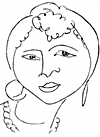

![]()
Rare Matisse Edition, Special Collections
Libraries Support Campus Growth
SPIRIT: Outreach Program Awarded Grant
Langson Reference Department Head
Student Research Fellowship Awards
UCI Libraries Honor Roll of Donors
Library Assistant Translates Etymologies
Pianist Josephson Gives Spectacular Performance
Cotman Discusses Brain Aging & Disease
Fall Exhibit Examines History of Book Illustrations
 |

The UCI Libraries have acquired a landmark title in the history of 20th-century book illustration: Charles Baudelaire’s Les Fleurs du mal, with lithographs by the great Impressionist Henri Matisse.
Jackie Dooley, head of Special Collections and Archives, noted that “Acquisition of this beautiful book makes a Matisse rarity available to UCI students and scholars of literature, art history, and visual studies for the first time.”
UCI Professor Emeritus of French Judd Hubert explains the significance of Matisse’s illustrations.
Baudelaire’s Les Fleurs du mal has been illustrated over the years by a variety of major artists, including Emile Bernard, Charles Despiau, Jacob Epstein, Gustave Rodin, Georges Rouault, and Pierre-Yes Trémois. Each interpreted selected poems more or less faithfully. Matisse took a different approach in the 1947 edition published by La Bibliothèque Française, of which UCI now owns the only copy in the University of California (320 copies were printed).

Mulatta model lithograph in Baudelaire’s Les Fleurs du mal, by Henri Matisse.
Instead of attempting to bring out the narrative qualities of the texts he chose, Matisse drew 33 portraits, including one of himself, one of Baudelaire, three of young men, and 29 of women. Instead of referencing the readily available likenesses of women associated with Baudelaire’s life, Matisse relied on models–one of them a mulatta–who also figure in his paintings and engravings. The lucid Matisse did not indulge in the biographical fallacies of the literary critics of his day who attempted to understand Baudelaire by associating each poem with the woman who may have inspired it. Thus, Matisse’s gallery of facial portraits provides a reactive accompaniment rather than a mimetic rendition of selected poems.
His well-known interest in the expressions and gestures of women, real or imaginary, suffices to explain his approach. In this respect, the Matisse illustrations of Les Fleurs du mal have much in common with his numerous etchings and lithographs of attractive women. Nonetheless, each of the portraits does take meaning into account in a rather special manner by its position, pose, or expression.
For further information or to view the volume, please contact Special Collections and Archives in Langson Library at 949.824.7227